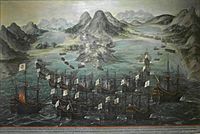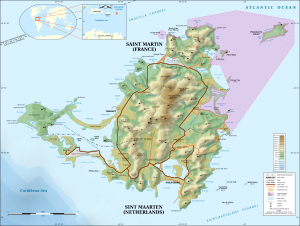Capture of Saint Martin (1633) facts for kids
Quick facts for kids Capture of Saint Martin |
|||||||
|---|---|---|---|---|---|---|---|
| Part of Eighty Years' War | |||||||
 Spanish capture of Saint Martin by Juan de la Corte (1597-1660), oil on canvas. Naval museum of Madrid |
|||||||
|
|||||||
| Belligerents | |||||||
| Commanders and leaders | |||||||
| Strength | |||||||
| 140 | 24 men-of-war 31 transports 1300 men |
||||||
| Casualties and losses | |||||||
| 3 ships captured 8 killed or wounded |
26 killed or wounded | ||||||
The Capture of Saint Martin was a battle where Spain took control of the island of Saint Martin. This happened during the Eighty Years' War, a long fight between Spain and the Dutch Republic. The island of Saint Martin is in the Caribbean Sea. It was important because it could be used by Dutch ships to attack Spanish trade routes.
Spain had claimed Saint Martin since Christopher Columbus explored the West Indies in 1493. But in 1633, the Dutch were using it as a base. Spain wanted to stop this, so they sent a large naval force to capture the island.
Contents
Why Spain Attacked Saint Martin
The Eighty Years' War and the Caribbean
The Dutch Republic had been fighting for its freedom from Spain since 1568. This conflict, known as the Eighty Years' War, wasn't just fought in Europe. It also spread to the Americas.
By the 1620s, Spain was worried. Ships from the Netherlands, France, and England were sailing into the Caribbean. They were attacking Spanish ships and colonies. A big event happened in 1628. The Dutch captured Spain's annual treasure fleet, which carried lots of gold and silver. This was a huge loss for Spain.
Protecting Spanish Colonies
Spain decided they needed to act. They focused on the Dutch base on Saint Martin. This island was a threat to their important colony in Puerto Rico.
In April 1633, a Spanish fleet sailed from Cádiz, Spain. Their mission was to kick out the Dutch. The fleet was led by the Marquess of Cadreita. He had an experienced commander named Lope de Hoces helping him.
The Battle for Saint Martin
On June 24, the Spanish ships got close to Saint Martin. They saw that the Dutch had built a strong fort. This fort had 22 cannons and was guarded by about 140 soldiers, including 40 enslaved people.
The Spanish commander, Cadreita, sent a message to the Dutch. He asked them to give up. The Dutch commander, Jan van Campen, was polite but said no.
Spanish Attack Begins
The Spanish ships then started firing their cannons at the fort. This helped their soldiers land on the island. Seven Spanish sailors died during this landing. By 2:00 AM on June 25, 1,000 Spanish troops were ashore.
The island had thick plants and trees, which made it hard to move. The soldiers didn't reach the fort until the next day. Some even died from the heat. Lope de Hoces, a Spanish leader, was badly hurt early in the fighting.
Taking the Fort
The Spanish brought four heavy cannons ashore. They set them up close to the fort and began firing. Cadreita had orders to capture the island quickly, within ten days.
On the night of June 30, the Spanish launched a direct attack on the fort. This attack cost them three dead and eighteen wounded soldiers. One of the wounded was a brave naval captain named Tiburcio Redín.
During the attack, the Dutch commander, van Campen, was also injured. The next day, he asked to surrender. Cadreita had been told to kill the Dutch soldiers, but he chose not to. Instead, he agreed to take them to the nearest Dutch territory.
After the Battle
The day after the surrender, Cadreita took control of the fort. He made its defenses even stronger. He added more powerful cannons and left a permanent group of 250 Spanish soldiers and 50 helpers to guard it.
The Spanish fleet then sailed to San Juan, Puerto Rico. They arrived on July 13 with the Dutch prisoners and three captured Dutch ships. The Spanish allowed all the island's people to leave. They raised the Spanish flag and held a special church service to give thanks for their victory.
However, Spain did not keep Saint Martin for long. The island was given back to the Dutch Republic in 1648. This happened as part of the Peace of Westphalia, which ended the Eighty Years' War.
Sources
- Lane, E Kris. Pillaging the Empire: Piracy in the Americas 1500-1750. M.E. Sharpe Publishers, ISBN: 0-7656-0257-1
- Hartog, Johannes History of Sint Maarten and Saint Martin
See also
 In Spanish: Recuperación de San Martín (1633) para niños
In Spanish: Recuperación de San Martín (1633) para niños


